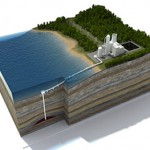 The UK already has the capacity to develop new green industries for capturing carbon dioxide emissions from industry and storing them deep underground. More investment is needed to further develop the relevant technologies and infrastructure, the scientists says in new research published these days.
The UK already has the capacity to develop new green industries for capturing carbon dioxide emissions from industry and storing them deep underground. More investment is needed to further develop the relevant technologies and infrastructure, the scientists says in new research published these days.
The authors, from the Grantham Institute for Climate Change at Imperial College London, have published two briefing papers that highlight the potential opportunities associated with adopting Carbon Capture and Storage (CSS) technologies and the challenges involved. The researchers say developing CCS on a large scale in the UK could promote economic growth, spawning new green technology companies and services that would build and maintain the CCS infrastructure.
CCS green technologies are designed to trap and transport carbon dioxide (CO2) from industry, via pipelines, and store it in offshore underground reservoirs. CCS green technology has been used extensively in the oil industry to recover fossil fuels from reserves and trap waste emissions in rock. However, CCS has never been used on a large scale to capture emissions from industry and power plants.
In the briefing papers, the authors say that the UK is in a unique position to develop CCS green technologies on a large scale. It has extensive oil industry expertise and a concentration of industries along the coast that are close to depleted offshore oil and gas reservoirs, which can store CO2.
A large-scale CCS network could be built along the east coast of the UK, suggest the researchers. This would use a pipeline network to carry CO2 from industries to local storage facilities called hubs, which would pump the gas onwards to offshore to underground reservoirs.
Humberside in the north of England is one place where a CCS network could work effectively, say the authors. Humberside has several existing power stations that emit 60 mega tonnes of CO2 per year. A pipeline network could pump emissions to hubs based in Humberside and on to underground reservoirs in the Southern North Sea.
However, the authors stress that there are still a number of obstacles to overcome before CCS green technologies can play a significant role in helping to mitigate climate change. More research needs to be done to improve current technologies for capturing CO2 so that they use less energy and are more cost effective to run. The researchers say that the UK government and industry needs to invest more money in research and development, so that rapid improvements can be made to CCS green technologies.
Governments will also need to develop credible policies and regulatory frameworks, say the researchers, to assess and manage the economic, health, legal and environmental issues associated with the full-scale use of CCS.
Dr Paul Fennell, one of the briefing paper authors from the Department of Chemical Engineering and Chemical Technology at Imperial College London, says: “The transition to full scale usage of CCS green technologies is quite a challenge as we’ll need to store several thousand times more CO2 than we do at the moment for CCS to have a significant impact on our environment. We need to design CCS systems that can cope with holding, transporting and storing these vast CO2 loads from our industries and power stations.”
Professor Martin Blunt, briefing paper author and Head of the Department of Earth Science and Engineering at Imperial College London, says: “The UK is in a unique position to really capitalise on carbon capture and storage technology, thanks to a combination of industry expertise, the right kind of geology and concentration of industry along the coast. We could be a beacon to other countries, showing them how new industries could help mitigate the effects of climate change and generate jobs in the process. However, the UK is moving at a frustratingly slow pace. Our research shows that carbon capture and storage green technologies are feasible and safe on commercial scale, however, governments and industry need to do more to ensure that CCS green technologies can play a vital role in reducing carbon emissions.”



